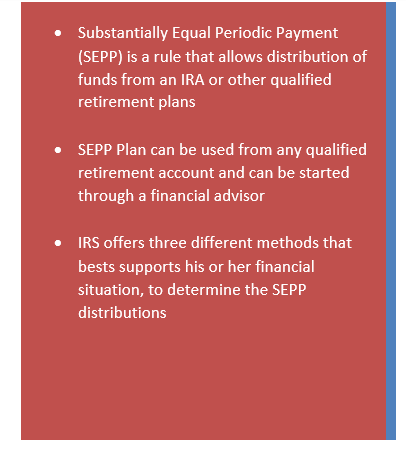What is Substantially Equal Periodic Payment (SEPP)?
Substantially Equal Periodic Payment (SEPP) rule allows one to distribute funds from an IRA or other qualified retirement plans before the age of 59 years and 6 months that avoids incurring IRS penalties for the withdrawal. If a person withdraws assets from the plan before the age, they have to pay 10% of the distributed amount as early withdrawal penalty. As the rule falls under IRS code section 72(t) and IRS sets out the formula to determine the amount to withdraw every year so, it is also known as 72(t) payments or SEPP payments.
You can only withdraw money according to schedule you choose to avoid penalties. IRS offers three different methods to figure out your which withdrawal schedule suits you best.

However, you can withdraw funds without any penalty, after the account holder turns 59 ½ or after the payment of annual distributions for a period of five years, whichever come later. But, income tax on withdrawals is taxable. The 72(t) payment plan is best for those who need a steady stream of pre-retirement income to make up for a job which they had to leave before than the expected date.
How does it work?
SEPP Plan can be used from any qualified retirement account and can be started through a financial advisor or directly with an institution, with the exception of a 401 (k) hold at your current employer.
IRS offers three different methods that bests supports his or her financial situation to determine the SEPP distributions, it include Required Minimum Distribution (RMD), Amortization and Annuitization. The withdrawal amount in this method will be pre-determined and can’t be changed every year for minimum two of the three options. If in case, you quit the plan before the minimum holding period than you have to pay penalties and interest on the plan’s distributions.

© 2021 Kalkine Media®
- Required Minimum Distribution (RMD)
In Required Minimum Distribution, you have to look for the reliable IRS table that will help you to know which divisor to use for your age. The SEPP annual payment is calculated by dividing the account balance by beneficiary and the life expectancy factor of the taxpayer each year.
However, this method required the annual amount to be recalculated annually, based on new prior year-end balance and age. But, this method allows lower annual withdrawal as compared to other methods.
- Amortization
Under the amortization method, SEPP payments are calculated same as the payment schedule on a loan, as it creates an annual withdrawal schedule that is same for each year of the plan. You may determine your SEPP payment by using the life expectancy of the accountholder and their beneficiary and a chosen interest of up to 120% of the mid-term rate federal Rate (AFR) and in this the SEPP payment based on the appropriate life expectancy table that offers you single life, joint life with non spouse beneficiary or uniform life, from which you have to choose one.
- Annuatization
The Annuatization method determines the annual payment same as pension or insurance company uses to calculate life annuity payout amounts. By using an annuity based, you may determine SEPP payment plan on the age of account holder and their beneficiary and a chosen interest rate same as amortization method guideline. The annuity factor is determined by using an IRS-provided mortality table.
The annuatization method gives the fixed annual payout amount as the amortization method.
Advantages and Disadvantages of SEPP Plan
You may consider SEPP Plan if you wish or need to withdraw the funds within short-term as it can allow a stream of income without any penalty in your 40s or 50s if you stop working before you planned. Additional funds can be withdrawn at your 59 ½ without penalty from your retirement accounts and by 60s you can withdraw your defined-benefit pension and social security. However, the restrictions are only for the time period until the payment term ends, which is five years or the account holder reaches age 59 ½, whichever comes later.
The disadvantage of the plan is that it is relatively inflexible as you have to stay with it for some duration and the amount you may withdraw depends on the payment method you choose. Also, if you quite the plan before the maturity you have to pay penalty plus interest.
The plan can also affect your financial security later in your retirement and if you stop SEPP payments it is tapping, which means its balance will not grow through further contributions. If you choose to withdraw amount early, you have to forego the earning it will make later, with the tax you save on the earnings, which will compound tax-free within the account.
 Please wait processing your request...
Please wait processing your request...